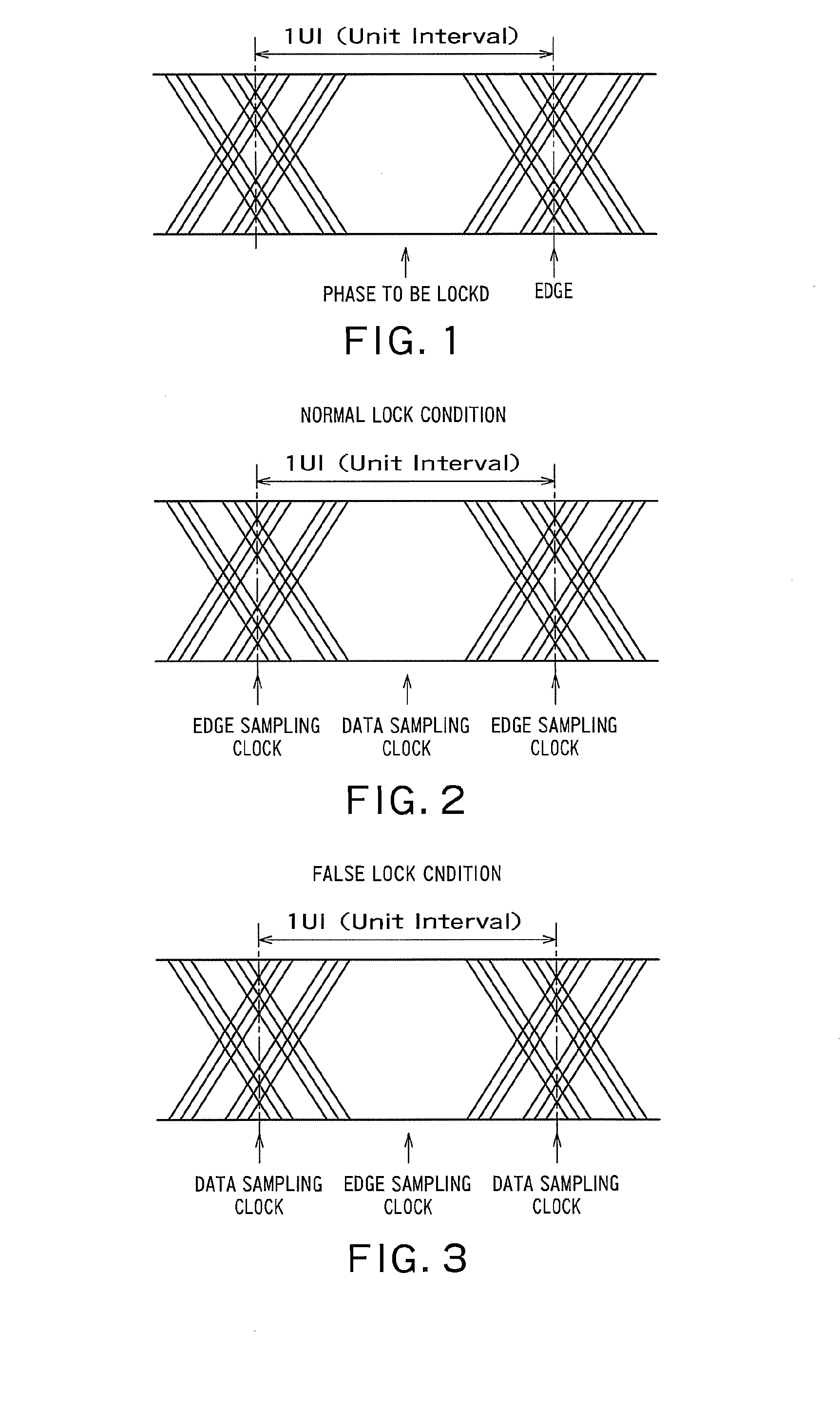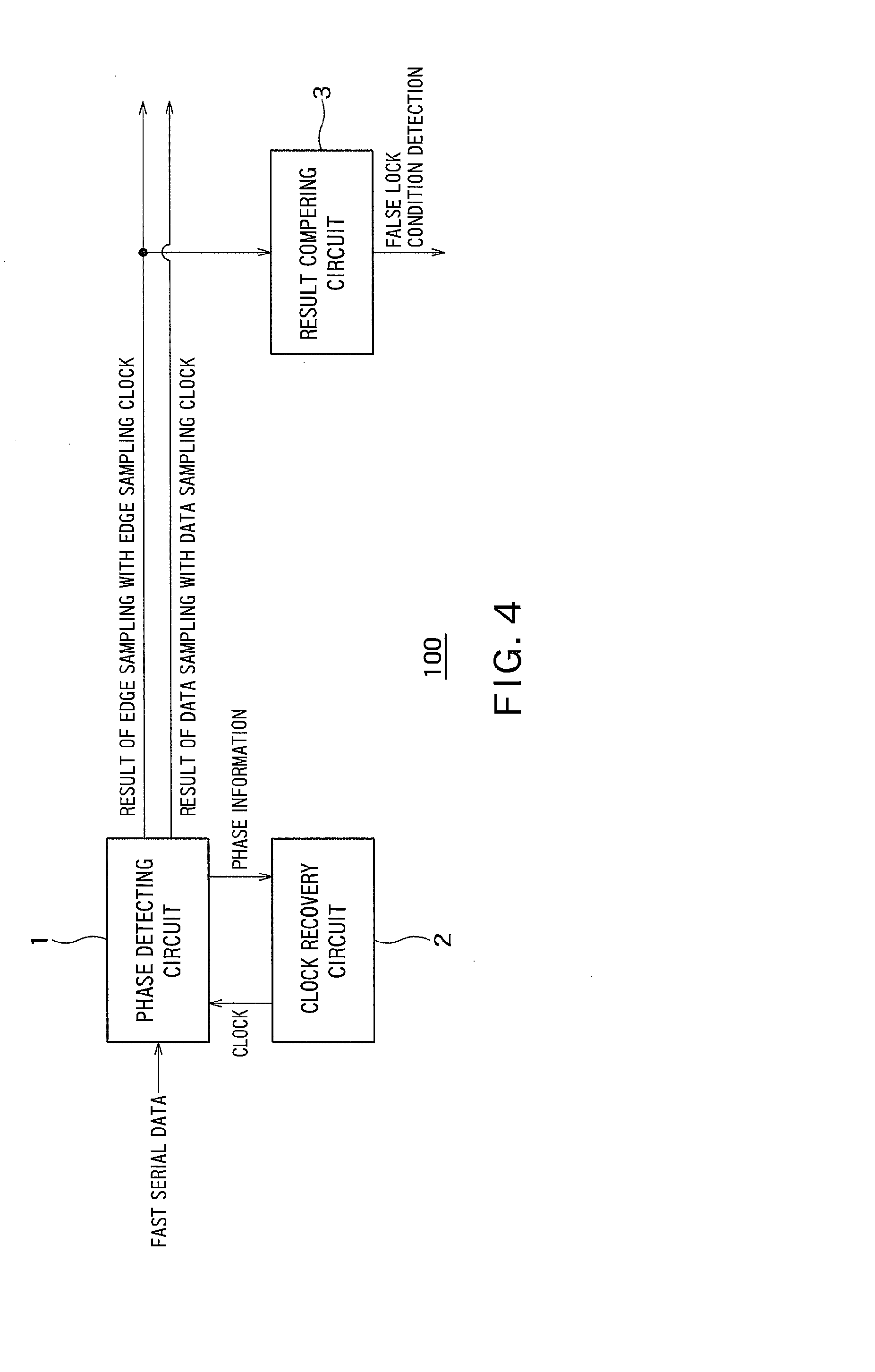Cdr circuit
a clock data and circuit technology, applied in the direction of digital transmission, pulse automatic control, pulse technique, etc., can solve the problem that the conventional cdr circuit used for fast serial data transmission can fall into a false lock condition
- Summary
- Abstract
- Description
- Claims
- Application Information
AI Technical Summary
Benefits of technology
Problems solved by technology
Method used
Image
Examples
first embodiment
[0025]FIG. 4 is a diagram showing an example of a configuration of a CDR circuit 100 according to a first embodiment.
[0026]As shown in FIG. 4, the CDR circuit 100 is configured to output a received data signal (fast serial data encoded by an 8B10B encoder) sampled with a clock. The CDR circuit 100 is used for Peripheral Component Interconnect (PCI) Express, Serial Advanced Technology Attachment (SATA), or USB3.0 (Super Speed USB).
[0027]The CDR circuit 100 includes a phase detecting circuit 1, a clock recovery circuit 2, and a result comparing circuit 3.
[0028]The clock recovery circuit 2 is configured to generate, from an external clock (not shown), a first clock as a data sampling clock with which data of the received data signal is to be sampled and a second clock as an edge sampling clock with which an edge of the received data signal is to be sampled.
[0029]The clock recovery circuit 2 determines whether the phase of the first clock is delayed or advanced from the phase of the dat...
second embodiment
[0042]In the above first embodiment, an example of the configuration of the CDR circuit that detects the false lock condition has been described.
[0043]In a second embodiment, an example of a configuration of a CDR circuit that detects a false lock condition and recovers from the false lock condition will be described.
[0044]FIG. 5 is a diagram showing an example of a configuration of a CDR circuit 200 according to the second embodiment. In FIG. 5, the same reference numerals as those in FIG. 4 denote the same components as those in the first embodiment.
[0045]As shown in FIG. 5, the CDR circuit 200 includes the phase detecting circuit 1, the clock recovery circuit 2, and the result comparing circuit 3, as in the first embodiment.
[0046]As in the first embodiment, the result comparing circuit 3 is configured to compare the edge sampling result with the preset data pattern, and determine that the false lock condition has occurred and output the false lock condition detection signal if th...
third embodiment
[0059]In the above second embodiment, an example of the configuration of the CDR circuit that recovers from the false lock condition by resetting the operation of the clock recovery circuit in response to the control signal output from the external system has been described.
[0060]In a third embodiment, an example of a configuration of a CDR circuit that recovers from the false lock condition by resetting the operation of the clock recovery circuit in response to the false lock condition detection signal output from the result comparing circuit will be described.
[0061]FIG. 6 is a diagram showing an example of a configuration of a CDR circuit 300 according to the third embodiment. In FIG. 6, the same reference numerals as those in FIG. 5 denote the same components as those in the second embodiment.
[0062]As shown in FIG. 6, the CDR circuit 300 includes the phase detecting circuit 1, the clock recovery circuit 2, and the result comparing circuit 3, as in the second embodiment.
[0063]As i...
PUM
 Login to View More
Login to View More Abstract
Description
Claims
Application Information
 Login to View More
Login to View More - R&D
- Intellectual Property
- Life Sciences
- Materials
- Tech Scout
- Unparalleled Data Quality
- Higher Quality Content
- 60% Fewer Hallucinations
Browse by: Latest US Patents, China's latest patents, Technical Efficacy Thesaurus, Application Domain, Technology Topic, Popular Technical Reports.
© 2025 PatSnap. All rights reserved.Legal|Privacy policy|Modern Slavery Act Transparency Statement|Sitemap|About US| Contact US: help@patsnap.com



